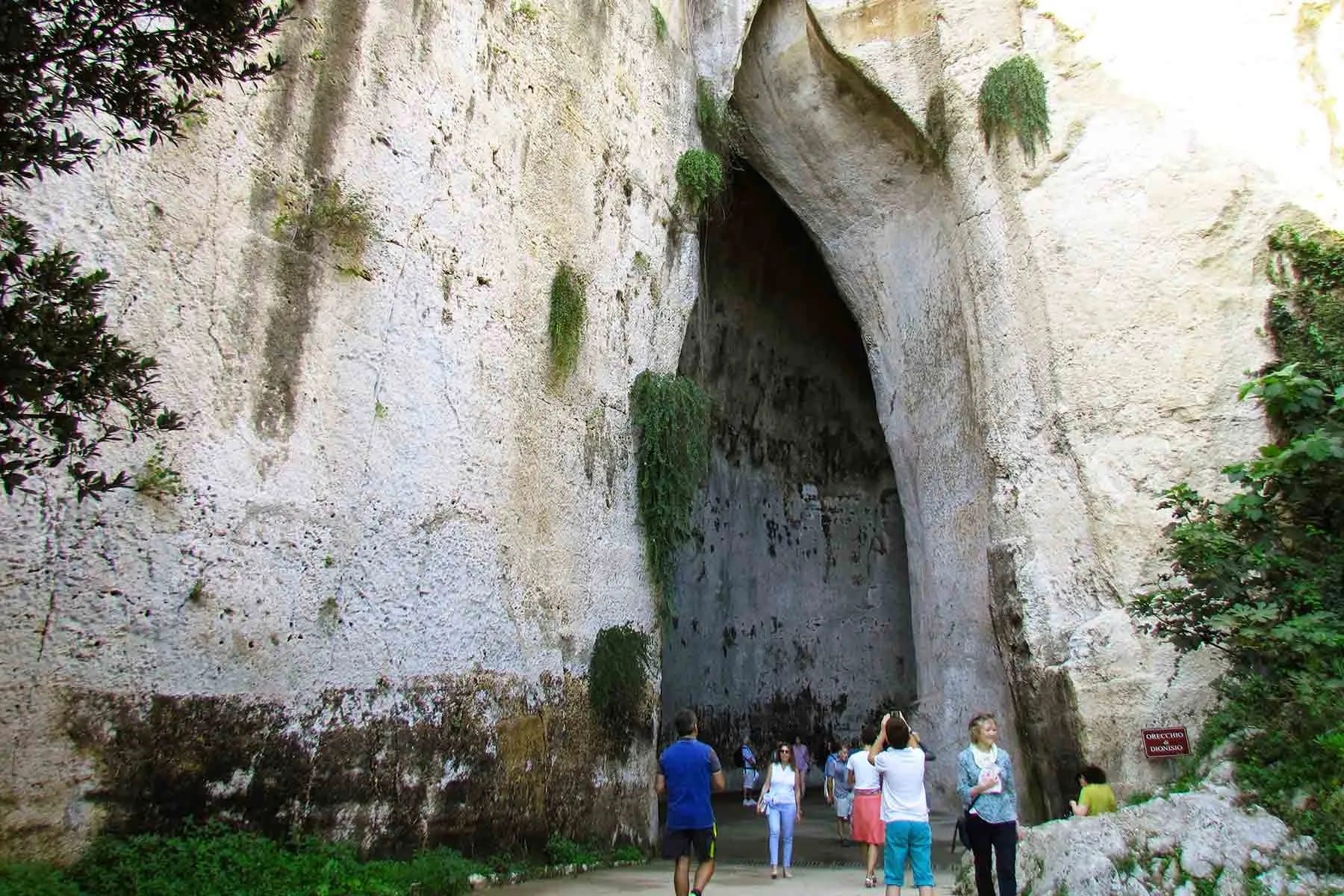The Ear of Dionysius, an ancient marvel of acoustic engineering carved into the heart of Syracuse, is shrouded in captivating legends. Located within the Latomia del Paradiso (Garden of Paradise), this peculiar grotto whispers tales of ancient rulers, ingenious engineering, and some truly mind-bending acoustics. Journey into this teardrop-shaped cavern and experience the chilling echoes that amplify the whispers of the past. Uncover the fascinating diabloceratops and edestus in our comprehensive guide to prehistoric creatures.
The Whispering Cave of Syracuse
Tucked away in the sun-drenched hills of Syracuse, Sicily, lies the Ear of Dionysius, a limestone cave renowned for its unusual shape and extraordinary acoustic properties. Its name, coined in 1608 by the painter Caravaggio, evokes the image of a giant ear listening to the secrets whispered within its depths. But how did this natural wonder come to be, and what secrets does it hold?
Origins and Construction
The Ear of Dionysius likely began as a simple limestone quarry within the Latomia del Paradiso, carved out during the Greek or Roman era (the precise date remains unknown). The ancient quarrymen employed a unique excavation method, starting with a narrow tunnel and expanding downwards and sideways. This method probably contributed to the cave’s distinctive teardrop shape and its remarkable acoustic qualities. Some historians also suggest it may have been used for water storage, a vital resource in the arid climate of Sicily.
The Legend of the Tyrant
The cave’s most famous association is with the notorious tyrant Dionysius I of Syracuse (405-367 BC). Legend has it that Dionysius used the Ear as a prison, exploiting its remarkable acoustics to eavesdrop on his captives. The story goes that he would sit in a hidden chamber above the cave’s 23-meter-high entrance, listening as the cave amplified even the faintest whispers, revealing plots and secrets. This chilling tale has become deeply intertwined with the cave’s identity, adding a layer of intrigue to its natural wonder. While captivating, the prison narrative lacks concrete historical evidence. Ongoing research continually seeks to uncover the true purpose of this enigmatic cavern.
Deciphering the Acoustics
The Ear of Dionysius is an acoustic marvel. Its smooth, reflective limestone walls and unique teardrop shape, extending 65 meters deep, create a natural amplifying effect. Whisper near the entrance, and your voice echoes back, magnified many times over. This phenomenon is likely due to a combination of factors: the focusing of sound waves by the curved walls, the highly reflective limestone surfaces, and the cave’s large resonating chamber, which allows for extended reverberation times.
| Feature | Description | Possible Explanation |
|---|---|---|
| Teardrop Shape | Narrow at the top, widening towards the bottom | Could focus sound waves towards the bottom |
| Smooth Limestone Walls | Highly reflective surfaces | Amplify sound through multiple reflections |
| Height (approx. 23 meters at entrance, extending to a maximum height of 65 meters) | Creates a large resonating chamber | Allows for long reverberation times |
| Varying Width | Changes the way sound waves travel | May create unique acoustic zones within the cave |
Ongoing research continues to refine our understanding of the cave’s complex acoustics. Scientists are exploring how sound waves interact with the irregular shape and the specific type of limestone, hoping to unlock the full secrets of its amplification.
The Ear of Dionysius in the Modern World
Today, the Ear of Dionysius is a popular tourist destination within the Neapolis Archaeological Park. Visitors can experience its unusual acoustics firsthand, whispering secrets into its echoing depths and imagining the whispers of history carried on the echoes. The cave’s recent appearance in the movie Indiana Jones and the Dial of Destiny, as the supposed location of Archimedes’ tomb, has further cemented its place in popular culture.
Visiting the Ear of Dionysius
Intrigued by the Ear of Dionysius? You’re in luck! This fascinating cave is open to the public within the Neapolis Archaeological Park in Syracuse, Sicily. A visit offers a unique sensory experience, where the echoes of the past mingle with the whispers of the present.
| Feature | Details |
|---|---|
| Location | Neapolis Archaeological Park, Syracuse, Sicily |
| Opening Hours | Generally 9:00 am to 6:00 pm (check for updates) |
| Admission | €10.00 |
| Height | 23 meters at the entrance, extending to a maximum height of 65 meters |
| Depth | 65 meters |
| Unique Feature | Exceptional Acoustics |
Dionysius I: The Tyrant of Syracuse
Dionysius I, the name forever linked to the Ear of Dionysius, was a complex and controversial figure. Rising from humble beginnings as a clerk, he seized power in Syracuse in 405 BC, transforming the Greek colony into a major Mediterranean power.
Rise and Reign
Dionysius I’s rise was marked by shrewd military strategy, political maneuvering, and ruthless ambition. He expanded Syracuse’s influence across Sicily and parts of southern Italy, engaging in protracted wars with Carthage. His reign was characterized by both grand achievements, such as the construction of the Euryalus fortress, and tyrannical methods, including alleged torture and imprisonment. The “Ear of Dionysius” legend, whether true or not, encapsulates the darker aspects of his rule.
Patron of the Arts and Intellectual Pursuits
Despite his tyrannical reputation, Dionysius I also patronized the arts and intellectual pursuits. His court attracted prominent figures like the philosopher Plato, suggesting a more nuanced personality than the brutal tyrant often portrayed.
Legacy
Dionysius I left an indelible mark on Syracuse and the ancient world. His story, with its mix of military brilliance, political intrigue, and tyrannical rule, continues to fascinate historians. The Ear of Dionysius stands as a physical reminder of his reign, its echoes whispering tales of a complex and controversial figure whose legacy remains a subject of debate and ongoing research.
- Unlock Elemental 2 Secrets: Actionable Insights Now - April 2, 2025
- Lot’s Wife’s Name: Unveiling the Mystery of Sodom’s Fall - April 2, 2025
- Photocell Sensors: A Complete Guide for Selection and Implementation - April 2, 2025
















